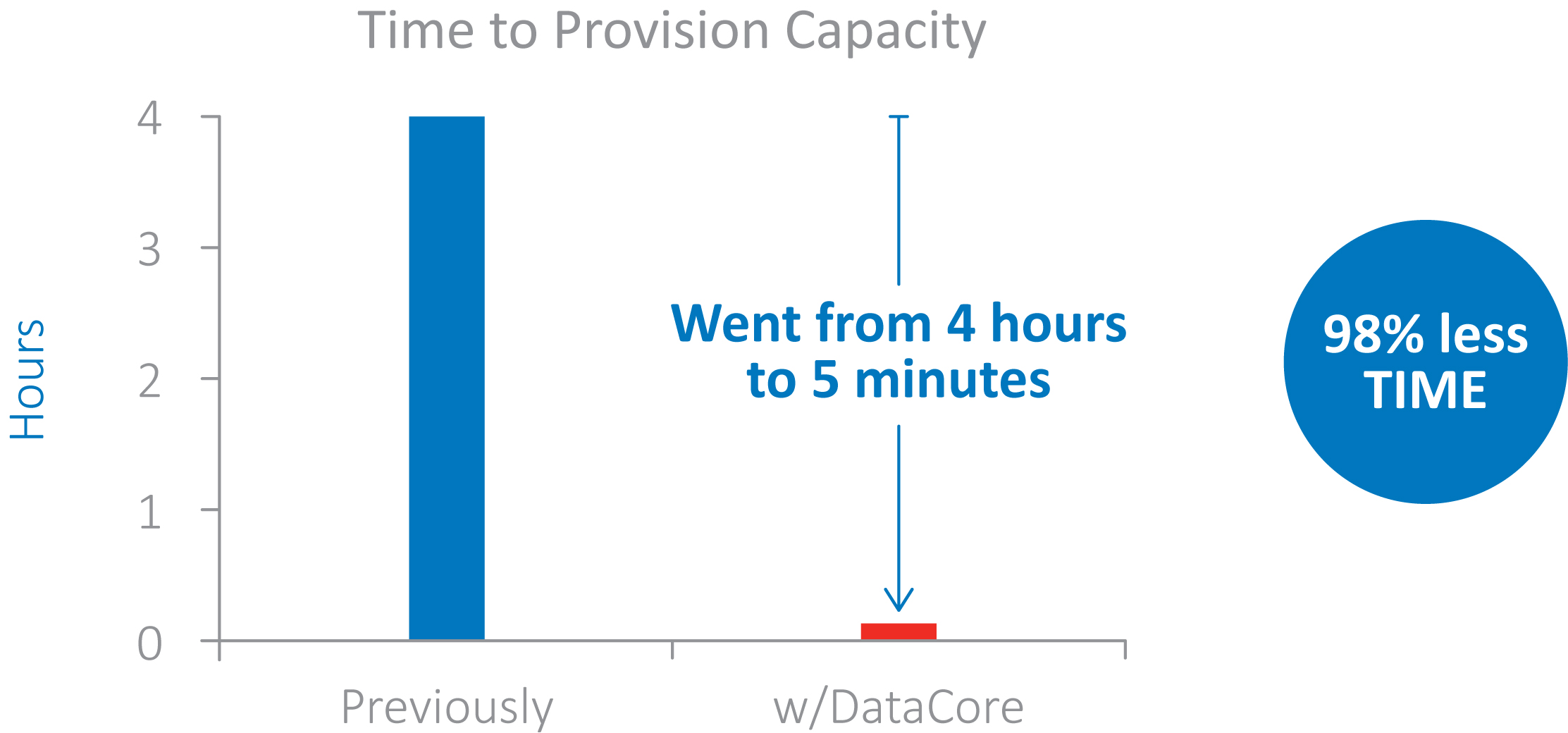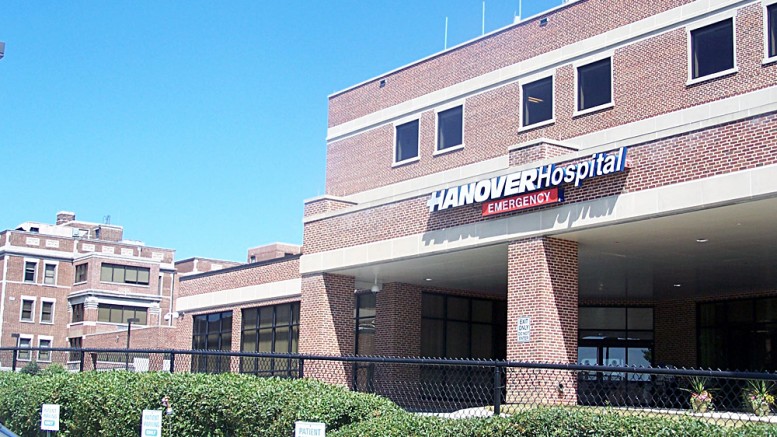Healthcare Organization Sees Significant Reduction in Storage Costs and Time Spent on Routine Storage Tasks
Hanover Hospital, an independent, not-for-profit community hospital based in Hanover, Pennsylvania, manages 6,000 patient and 190,000 outpatient visits annually, generating an average of 600,000 lab tests and 90,000 imaging scans. With these kinds of numbers, the hospital needed to find a storage solution that could keep up with its application needs and provide increased storage capacity, improved resiliency and accelerated performance. After weighing various options, the hospital chose DataCore Software, the leader in Parallel-Powered Software, Application-Adaptive Data Infrastructure and Hyper-converged Virtual SAN solutions, to virtualize its storage infrastructure.
“If we had gone down the existing path we were on with our traditional SAN, it would have been a very lengthy process to acquire the storage and to deploy the storage to ESX servers in the environment,” said Douglas Null, Supervisor of Technical Support. “We wanted something we could quickly scale, and is simple to manage – all while not impacting performance. Additionally, we did not necessarily want flash storage if we did not need it.”
Null, who is charged with providing technical leadership for the IT infrastructure, including servers, storage, networking, security, as well as technology and application conversion, and his IT team at Hanover faced numerous challenges with the incumbent storage vendor. For one, new departmental applications needed to be deployed quickly. In addition, these applications required a significant amount of storage capacity, which was beyond what the current storage array could support. A storage upgrade using the incumbent vendor was considered. However, the high cost-for-performance consideration quickly made this an unviable option. The performance concern was compounded by the fact that any new storage needed to have the ability to support even more applications in the future.
The IT team at Hanover needed a solution that helped them meet their application requirements. They needed the ability to quickly scale, keeping the applications available far more efficiently than they had been able to do so in the past. Hanover Hospital did want to be tactical and go down the same old path of deploying new applications on a replicated, traditional two-array SAN configuration. Instead, the IT team began looking for a smarter, more strategic option.
Becoming Software-Defined with DataCore: Reducing Time Spent on Routine Storage Tasks and Reducing Storage Costs
Hanover Hospital trusted DataCore to virtualize its storage infrastructure because the hospital did not have to upgrade its existing, underlying storage – thereby making a CapEX outlay much lower. Hanover started with a single DataCore installation and over a handful of years the hospital added synchronous mirroring that stretched storage availability between its two on-campus data centers.
Today, DataCore’s adaptive, self-learning and healing technology is taking the pain out of manual processes and helps deliver on the promise of the new software-defined data center through its hardware agnostic architecture. With DataCore, Hanover Hospital has drastically reduced the time spent on routine storage tasks and has reduced storage costs – all while increasing capacity utilization and the performance of its applications. What’s more, high-availability storage at Hanover has significantly reduced the time it takes to provision storage and systems.
TOP 3 REASONS FOR SELECTING DATACORE
- DataCore was 90% less than total price on EMC
- Quickly scale performance for VMs and applications
- Active / active, zero touch failover and failback

The Software-Defined Approach Delivers Better Operational
One of the other benefits of software-defined storage with DataCore that has significantly helped Hanover Hospital has been the overall operational simplicity of storage management that is made possible by the storage virtualization software. Provisioning a DataCore environment is truly straightforward and, according to Null, is “essentially a two-step process.” This software-defined approach took provisioning from four hours down to five minutes. This is because DataCore SANsymphony-V excels in automating storage-related tasks – whereas the steps needed to provision storage in a way other than the DataCore way are simply daunting. With a traditional SAN set in an active-active configuration, Null and others at Hanover would be tasked with configuring an equipment storage solution on one side, then configuring the equipment storage solution on the other side. Then, they would have to configure the replication between the two sites. They would also have to configure journals and logs. Finally, they would need to configure Site Recovery Manager (SRM) from VMware that is used to failover the VMs from site to site.
“As you can see, we save a lot of time in even the most simple configuration by provisioning storage in both of our data centers with DataCore,” Null emphasized.
What’s more, Hanover now has the ability to better manage capacity through thin-provisioning. According to Null, the IT environment at Hanover is about 60% over-provisioned. This benefits the organization by allowing it to not have to add new storage when new systems come online. Existing storage can be allocated to new systems immediately and overall storage can be expanded down the road. When new systems are introduced, the IT team simply thin-provisions virtual volumes of storage and presents them to the ESX hosts as well as to the VMs. By doing so, Hanover saves both time and money.
A Virtualized, Agile Infrastructure that Super-charges Performance, Scales to Manage Data Growth and Eliminates Downtime
Hanover has seen very good performance with DataCore SANsymphony-V. In fact in one instance where a RAID 5 virtual volume was mirrored between the two sites, the IT team was particularly impressed. This was when the team used a tool from Veeam to monitor the VM disk metrics of a VMware ESX 5 VM, they realized by all that the particular application was taking well over 1,000 IOPS/second on the DataCore-powered storage, however, the latency on the data stored was “nil” and the reads were never even hitting the backend physical disk because of the DRAM caching that is part and parcel of the DataCore SANsymphony-V.
Significantly, when the IT team at Hanover breaks down the technology that is running on the EMC storage versus the technology running the VM’s that run on the DataCore virtualized storage platform back-ended by HP MSA, of the 266 total VMs, 140 are now running on the DataCore software-defined storage platform.
The two data centers are connected by dark fiber. Roughly 90% of the infrastructure is run on VMware vSphere. The majority of the “compute” is done on 34 HP DL380 servers. On these servers, the hospital has approximately 266 virtual machines (VMs) running. Hanover is using EMC and HP MSA arrays as its current storage platforms, with the HP MSA’s used specifically to support the DataCore deployment.
DataCore SANsymphony-V now serves as a unified storage services platform across the entire multi-site infrastructure. In particular, it is relied upon extensively for various mission-critical, clinical and enterprise applications. Examples of these include the components of the hospital’s MEDITECH EMR, clinical middleware, medical dictation and transcription services, components of an Ambulatory HIS, a Medisolv BI reporting platform, Citrix XenApp, Infrastructure Management and Monitoring Applications, multiple Microsoft product offerings such as Microsoft SQL and MySQL, as well as other applications.
Hanover Hospital reports that with DataCore SANsymphony-V deployed in a synchronous mirror configuration, it has realized continuous uptime through with its high-availability storage and has significantly reduced the time it takes to provision storage and systems.
Today, Hanover Hospital is, according to Null – “A happy DataCore customer with well over half of our environment running on DataCore-powered storage.”

